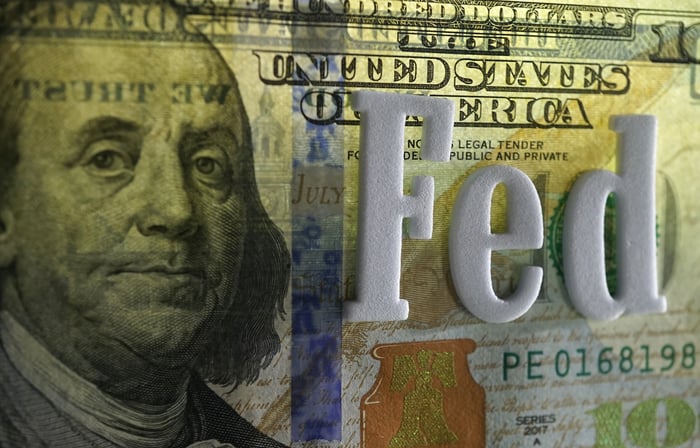Stocks are riding high heading into 2024.
A recovery from the 2022 bear market, excitement about new generative artificial intelligence (AI) technologies, and expectations that interest rates will soon come down have propelled the stock market to a banner year, and investors are hopeful that momentum will continue into 2024.
While there are plenty of forecasts about the stock market in the new year, no one really knows what will happen. The economy could strengthen or weaken. Geopolitical strife could take a turn for the worse. Generative AI could start to fulfill its promise or disappoint the market.
Though there's plenty of uncertainty, there is one important thing we do know about 2024. We know that investors are expecting three quarter-point interest-rate cuts from the Federal Reserve. We know this because the central bank gave that forecast at its last meeting in December, and because investors closely watch the Fed's rate decision. For example, the S&P 500 (^GSPC 1.02%) jumped 1.4% on Dec. 13, the day the Fed gave its rate-cutting forecast, and it had previously jumped nearly 2% on Nov. 14, when a cooler-than-expected inflation report increased the chances that rate cuts may be coming soon.
Of course, a forecast isn't written in stone, but it's worth examining what usually happens when the Fed cuts rates to see if investors should expect another strong year.

Image source: Getty Images.
A Fed history lesson
The relationship between the stock market and interest rates is well understood and underpinned by the principles of finance. When interest rates rise, stock valuations tend to fall because bonds become more attractive as an alternative investment. On the other hand, when interest rates fall, the opposite is true. Stock valuations rise as money moves from the bond market into stocks.
Other factors are at play, however, including the health of the economy. As the following chart shows, there have been three major rate-cutting cycles since 2000.
Effective Federal Funds Rate data by YCharts
The Fed cut rates starting in 2000 as the dot-com bubble burst, it cut them in 2007 and 2008 during the great financial crisis, and it cut them in 2019 and early 2020 as the coronavirus pandemic hit.
The performance of the stock market during those periods is mixed. Stocks crashed during the dot-com bust but began to mount a comeback toward the end of that rate-cut cycle. During the financial crisis, they also tumbled.
Finally, in 2019, toward the end of a decade-long bull market driven in part by several years of near-zero interest rates, stocks gained with the help of the initial rate cuts, briefly crashed when the pandemic started, and then surged again when monetary and fiscal policy adjusted to the realities of the pandemic.
Why this time could be different
There's an important difference between this expected rate-cut cycle and the earlier ones this century. The other three coincided with a recession, as the following chart shows.
Effective Federal Funds Rate data by YCharts
The blue line shows GDP growth. Two straight quarters of negative GDP is typically understood to be a recession. There were recessions during each previous rate-cut cycle, but one isn't expected this time, as the economy has proved to be resilient over the past year and the unemployment rate is still low.
Typically, rate cuts are prompted by economic weakness. However, this one seems to be more of a correction for the Fed's aggressive rate increases to counter inflation, now that inflation is close to the central bank's goal of 2%.
As the blue line in the following chart shows, inflation was less of an issue in the previous rate-cut cycles.
Effective Federal Funds Rate data by YCharts
In some ways, this rate cycle has more in common with the "Volcker Recession" of the early 1980s, when then-Fed Chair Paul Volcker raised rates aggressively to tame inflation, which was much higher then. As the following chart shows, the Fed funds rate was volatile during that period, but when the rate came down steadily in 1982, the stock market soared, with the S&P 500 gaining more than 60% in less than a year.
Effective Federal Funds Rate data by YCharts
Importantly, that rebound also came at the end of a recession and a bear market.
What do rate cuts mean for the stock market in 2024?
There's no perfect historical comparison for the current stock market. As with the Volcker Recession, the previous rate increases came from the need to control inflation rather than to grease the economy, but this is a different moment from 1982. Stocks are already at all-time highs after a bullish 2023, as investors seem to have already baked in next year's rate cuts.
That could mean that the Fed will have to get even more dovish than expected in order to fuel stocks higher, meaning it would have to do more than three rate cuts to exceed expectations.
Regardless, falling rates should help the stock market and give certain businesses a boost, but investors should be aware that expectations of rate cuts may already be priced in.
Still, other factors could keep the recent rally going, including corporate earnings growth, strong economic data, and continued breakthroughs with generative AI.
As investors prepare for a new bull market, expect stocks to continue to rise in 2024, as the stock market is likely to benefit from the Fed's more accommodative monetary policy, even if anticipation of it has already pulled stocks higher.







